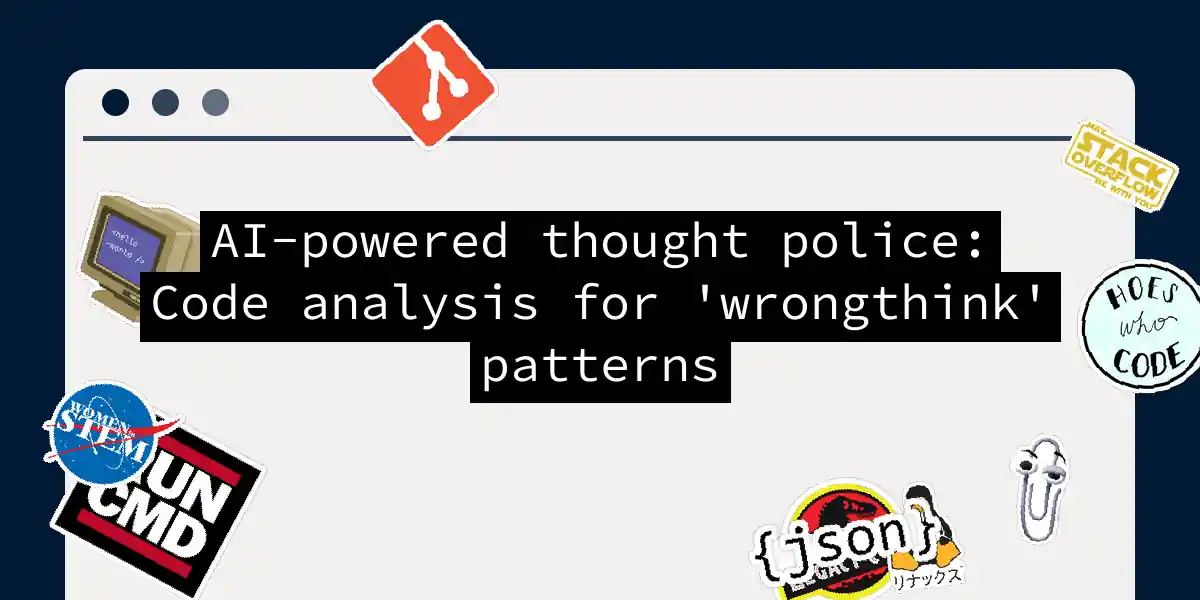The Digital Mind Police Are Knocking (And They Brought Python)
Picture this: You’re debugging code at 2 AM when an automated email pings: “Warning: Pattern 7C detected in commit #a3f8b2. Mandatory re-education module assigned.” Welcome to the future of AI-powered ideological compliance, where your variable names could land you in a virtual sensitivity training session. Let’s dissect how “wrongthink” detectors work – and why they’re scarier than a segfault in production.
How Thought-Sniffing Algorithms Work
Modern “wrongthink” detectors combine NLP and symbolic analysis to flag ideological deviations. Here’s their three-step interrogation process:
- Lexical Tattooing
AI scanners first map your code’s linguistic DNA:Even innocent comments likedef scan_ideology(text): # Detects terminological red flags red_flags = ["legacy_system", "tradition", "revolution", "purge"] return any(flag in text.lower() for flag in red_flags)// This legacy system works finebecome ideological markers. - Semantic Gravity Wells
Contextual embeddings analyze conceptual proximity:graph TD A[Code Comment] --> B(Embedding Model) B --> C{Vector Comparison} C -->|Close to| D["'Dangerous Concepts'"] C -->|Far from| E["'Approved Ideas'"] D --> F[Flagged]Your mention of “efficiency” near “regulation” might score 0.87 on the dangerous-association scale. - Pattern Archaeology
Digs through commit histories like a digital Stasi:git-ideology-scanner --diff HEAD~5..HEAD --sensitivity 0.9 # Checks if recent commits shift toward # statistically 'deviant' patterns
Building Your Own Wrongthink Detector (For Science!)
Let’s build a basic ideological scanner in Python. Disclaimer: I’m demonstrating this so you can recognize the tech – not deploy it.
Step 1: Install Dependencies
pip install transformers scikit-learn ideological-compliance==0.7
Step 2: Configure Thought Parameters
Create compliance_rules.yaml:
ideology_profiles:
- name: "Corporate Conformity"
approved_terms: ["synergy", "paradigm shift", "move fast"]
forbidden_terms: ["unionize", "open source", "ethics"]
vector_threshold: 0.75
Step 3: The Compliance Engine
from ideological_compliance import ThoughtScrutinizer
def audit_codebase(repo_path):
scanner = ThoughtScrutinizer(
config="compliance_rules.yaml",
model="corporate-ideology-v4"
)
# Scan all .py and .md files
report = scanner.inspect(
repo_path,
file_extensions=[".py", ".md"]
)
for violation in report["violations"]:
print(f"🚨 FILE: {violation['file']}")
print(f" LINE {violation['line']}: '{violation['snippet']}'")
print(f" DEVIATION SCORE: {violation['score']:.2f}")
Why This Terrifies Me More Than Unhandled Promises
- The Bias Boomerang
These systems inherit training data biases. A model trained on corporate GitHub repos might flag “workers’ rights” as ideological extremism. - The Creativity Ice Age
Wheninnovation = deviation, we’ll see codebases as bland as cafeteria oatmeal. Remember when “disrupt” was praised? Now it’s literally disruptive. - The Opacity Problem
Most compliance tools are black boxes. You get flagged with zero explanation – just like my ex’s breakup text.
The Ethical Debug Console
Before deploying such systems, consider these questions:
- Who defines “rightthink”? (Hint: It’s never junior devs)
- How do false positives affect careers?
- Can you appeal to a human? (Spoiler: The “human” is an underpaid contractor in a 3rd-floor cubicle)
Final Thought: The Ideological Toggle
Some organizations are flipping the script:
if IDEOLOGICAL_COMPLIANCE_ENABLED:
self.censor(deviation_score=0.6)
else:
self.celebrate_diversity_of_thought()
But toggle switches only work if someone has the courage to flip them. What good is a watchdog that only bites the “other” side? Where do we draw the line between legitimate code review and digital McCarthyism? The keyboard is yours…
